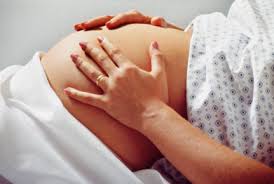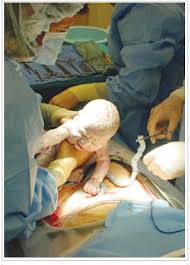December 26th, 2011 by BarbaraFederOstrov in News, Research
No Comments »
 Domestic Violence: 25 percent of women surveyed by the government say they were violently attacked by their husbands or boyfriends in a finding one federal official called “astounding,” the Associated Press reports.
Domestic Violence: 25 percent of women surveyed by the government say they were violently attacked by their husbands or boyfriends in a finding one federal official called “astounding,” the Associated Press reports.
C-Sections: The number of births by Cesarean section in Calif. has risen 50 percent in the past 10 years, new research shows, but it isn’t because of the health benefits over vaginal delivery. Researchers cite financial incentives for doctors and an “awareness gap” of the procedure’s risks among the explanations, Stephanie O’Neill reports for KPCC public radio.
Health Reform: South Carolina Gov. Nikki Haley predetermined the findings of a state committee working on health reform even before Read more »
*This blog post was originally published at Reporting on Health - The Reporting on Health Daily Briefing*
September 3rd, 2011 by Linda Burke-Galloway, M.D. in Health Tips
No Comments »

 At some point during a pregnancy, the topic of labor induction might emerge. Inducing labor means that contractions are being started before a patient begins labor naturally or without any external influence. Elective inductions of labor has doubled in the past 20 years according to medical literature. Early term inductions of labor that begin between 37 and 38 weeks have quadrupled from 2 to 8% within the U.S. Inductions are usually done when the risk of maintaining the pregnancy poses a threat to the mother or fetus. However, more and more patients have requested to have an induction of labor based on personal preference. Early elective inductions have recently been criticized because of an association with an increase in fetal and newborn complications as well as an increase in the C. Section rate.
At some point during a pregnancy, the topic of labor induction might emerge. Inducing labor means that contractions are being started before a patient begins labor naturally or without any external influence. Elective inductions of labor has doubled in the past 20 years according to medical literature. Early term inductions of labor that begin between 37 and 38 weeks have quadrupled from 2 to 8% within the U.S. Inductions are usually done when the risk of maintaining the pregnancy poses a threat to the mother or fetus. However, more and more patients have requested to have an induction of labor based on personal preference. Early elective inductions have recently been criticized because of an association with an increase in fetal and newborn complications as well as an increase in the C. Section rate.
The Bishop Score was developed in the 1960’s by Dr. Edward Bishop as a means of evaluating the cervix to determine if the patient would successfully have a vaginal delivery. Based on Bishop’s research, he determined that women who were pregnant for the first time and women who had an “unfavorable” cervix were Read more »
*This blog post was originally published at Dr. Linda Burke-Galloway*
May 24th, 2011 by Linda Burke-Galloway, M.D. in Health Policy, Opinion
No Comments »

 “But for the grace of God go I.” My late aunt drilled that value into my six-year old head and it has never left. An article regarding a New York politician recently caught my attention. When New York State enacted a bill to ban the shackling of pregnant prisoners, a New York State Assemblywoman objected. The article goes on to discuss the case of Jeanna M. Graves, who, in 2002 was arrested on a drug charge and began a three year sentence. Graves was pregnant with twins and while in labor, was handcuffed during her entire C. Section. How utterly ridiculous.
“But for the grace of God go I.” My late aunt drilled that value into my six-year old head and it has never left. An article regarding a New York politician recently caught my attention. When New York State enacted a bill to ban the shackling of pregnant prisoners, a New York State Assemblywoman objected. The article goes on to discuss the case of Jeanna M. Graves, who, in 2002 was arrested on a drug charge and began a three year sentence. Graves was pregnant with twins and while in labor, was handcuffed during her entire C. Section. How utterly ridiculous.
Before a C. Section begins, a patient is usually given either an epidural or spinal anesthesia. On rare occasions, she is put to sleep with general anesthesia if the baby must be delivered emergently. On all accounts, the patient’s legs will either be numb from anesthesia or she will be sleeping. Why then does she need shackles? She’s certainly not in a position to run. Although I addressed this issue last August, it needs to be revisited again. Read more »
*This blog post was originally published at Dr. Linda Burke-Galloway*
March 3rd, 2011 by Linda Burke-Galloway, M.D. in Better Health Network, Health Tips
No Comments »

 Having a baby can be a beautiful thing until something goes wrong. The tragedy is that many high-risk conditions can be managed appropriately if the patient is cooperative and the healthcare provider is competent and well trained. Unfortunately, almost 600 pregnant women die in the U.S. each year from complications and the most common complication is significant blood loss after birth or postpartum hemorrhage (PPH).
Having a baby can be a beautiful thing until something goes wrong. The tragedy is that many high-risk conditions can be managed appropriately if the patient is cooperative and the healthcare provider is competent and well trained. Unfortunately, almost 600 pregnant women die in the U.S. each year from complications and the most common complication is significant blood loss after birth or postpartum hemorrhage (PPH).
PPH occurs when there is a blood loss of 500 cc or greater for a vaginal delivery and 1,000 cc after a cesarean section (C-section). Or, if you were admitted with a hemoglobin of 12 and it drops by ten points to 11, there should be a high index of suspicion for PPH as well. Therefore, if you feel lightheaded or dizzy, have palpitations or an increased heart rate after delivering a baby, inform the hospital staff immediately.
The most common cause of PPH is uterine atony or lack of contractions after the baby is delivered. Any pregnant condition that stretches the uterus significantly — such as having twins or a higher gestation, excess amniotic fluid (aka polyhydramnios), a prolonged induction of labor (greater than 24 hours) — increases the risk of PPH. Retained products of conception, such as the placenta, also places the patient at risk for developing PPH.
Other risk factors for PPH include:
- Women with a known placenta previa
- African-American women
- Hypertension or preeclampsia
- Mothers with infants weighing greater than 8.8 pounds (or 4,000 grams)
- Mothers with greater than seven children
- Women with a history of hemophilia
If you have any of the risk factors listed above, please be proactive and discuss the possibility of a PPH with your healthcare provider. Read more »
*This blog post was originally published at Dr. Linda Burke-Galloway*
January 11th, 2011 by Linda Burke-Galloway, M.D. in Better Health Network, Health Tips
No Comments »

 Although I’ve been a proponent for the prevention of medical errors for years and wrote a book to address those issues, I think my obstetrician-gynecologist (OB/GYN) colleagues are finally catching on.
Although I’ve been a proponent for the prevention of medical errors for years and wrote a book to address those issues, I think my obstetrician-gynecologist (OB/GYN) colleagues are finally catching on.
Dr. Patrick Duff of the University of Florida’s OB/GYN department wrote an article in the December issue of the journal Obstetrics & Gynecology that caught my attention. In his article, “A Simple Checklist for Preventing Major Complications Associated with Cesarean Delivery,” Duff outlines steps that OB/GYNs should take in order to reduce complications during and after a cesarean section. Duff patterns his list after Dr. Atul Gawande’s book, “The Checklist Manifesto: How to Get it Right,” which has set the standard regarding reducing complications after surgery. According to Duff, the following steps should be taken in order to reduce complications after a cesarean section:
1. Clip hair at the surgical site just before making the incision to reduce wound infections. Duff states that there is a greater chance of promoting infections when the hair is shaved the night before the procedure. He also recommends clipping hair as opposed to shaving which reduces the rate of would infections.
2. Cleanse skin with chlorhexidine solution rather than iodine because medical studies have demonstrated a reduction in infections using chlorhexidine solution.
3. Give broad spectrum antibiotics before the surgical incision as opposed to after the newborn’s umbilical cord is clamped. Read more »
*This blog post was originally published at Dr. Linda Burke-Galloway*
 Domestic Violence: 25 percent of women surveyed by the government say they were violently attacked by their husbands or boyfriends in a finding one federal official called “astounding,” the Associated Press reports.
Domestic Violence: 25 percent of women surveyed by the government say they were violently attacked by their husbands or boyfriends in a finding one federal official called “astounding,” the Associated Press reports.












